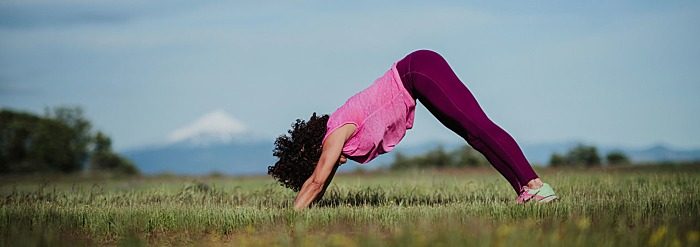Pose of the Day: Downward-Facing Dog
Our quadrupedal friends have all the secrets. They move based on how they feel and they don’t worry about how they look. They simply stretch. The yoga asana Downward-Facing Dog (Adho Mukha Svanasana) takes directives from our canine friends and mimics their shape as they walk their front paws forward, stretching their legs after a mid-day nap. If we asked a dog how it felt to be in this asana, their answer might be like ours. We feel a stretch through the back of our legs, along our spinal muscles, and around our shoulders. It feels amazing after sitting for long periods of time and is a superb way to prep the body for more movement. As dogs are exemplary of movement guided by energy, it’s also beneficial for us to move by our own inner cues. Still, you’ll be weight-bearing on your hands in Downward-Facing Dog, so it’s helpful to have some tips and tutorials to stay free of injury. Without further ado, here’s how to be your dog’s doppelganger.
Through the Ayurvedic Lens
Downward-Facing Dog can be balancing to all doshas. The strength of pushing downward makes you firmly rooted to the ground and invokes a feeling of safety and stability. This is akin to the energy of apana vayu. Yet as your head is lower than your heart, the grounding feeling is accompanied by a circulating, invigorating energy that creates lightness like we feel with both udana and vyana vayu. When using this pose to pacify vata, emphasize the anchored, still qualities. To pacify pitta, hold for a shorter amount of time, releasing before there is an influx of heat. For kapha, hold a little longer and use some exploratory movements within the shape to help uplift.
How to Practice
Begin on your hands and knees. With your feet hip distance apart, tuck your toes under and start to slowly lift your knees and straighten your legs. Reach upward with your hips as you simultaneously shift your weight back, sharing the effort between your upper and lower body. You’ll start to feel a stretch through your hamstrings and calves that increases with the polarity of lifting your sitting bones upward and pressing your heels downward. These dual energies happen in your upper body, too. Match the upward reach of your sitting bones with the downward action of your hands, creating more strength and support. Your aim is to look like an upside down “V” with your hips, shoulders, and hands aligned on one plane and your hips, knees, and heels on another. Being present with the muscles that are supporting you and those that are stretching, breathe five slow breaths. Carefully lower your knees to return to your starting point.

Variations or Modifications
- Holy hamstrings! Downward-Facing Dog is really good at illuminating the tension in the back of your legs. When your hamstrings feel like they don’t want to stretch, they can pull on your back, causing it to round or to feel like there is too much weight in your upper body. To solve this, either bend your knees slightly, take your feet wider, or place your hands on yoga blocks at a stable height. Blocks are useful in that they change the angle at your hips, making it easier to elongate.
- If you have a past or present shoulder injury, or think you might have one brewing, you may want to avoid Downward-Facing Dog completely. Because we spend a lot of time on our devices with our shoulders rounded forward, it can be quite a lot to bear weight in your arms when they are overhead. If you aren’t eliminating it entirely, be ultra-aware of your shoulder positioning. Prevent your shoulders from dipping and avoid excessive internal rotation. Internal rotation at your shoulders rolls them toward the thumb side of your hands and results in a shrugging or compressed feeling that can lead to injury.
- Wrist complaints are common when first starting Downward-Facing Dog. Often the complaint is discomfort and you may simply need time to build strength. Pushing equally through your palms and fingertips, as opposed to resting the weight in the heel of the hand, can help in the meantime. If there is pain, which could come from arthritis or nerve compression such as in the case of carpal tunnel, grab your yoga blocks again. Placing your hands on yoga blocks reduces the amount of wrist extension, which is typically the primary reason for pain and discomfort.
Contraindications
If you have a shoulder or wrist injury, wait until given permission from your healthcare practitioner before trying Downward-Facing Dog. Additionally, being upside down increases the pressure in your head, so also take caution if you have high blood pressure, glaucoma, or even a common headache or sinus infection.
Counter-Balancing Pose
You can counter the physical and energetic state of Downward-Facing Dog with some time in Child's Pose (Balasana). As you lower to your knees from Downward-Facing Dog, flip your feet so that the top side is facing down. Take your knees wide and keep your feet together as you press your hips back towards your heels. Let your arms rest alongside your body with your palms facing up to give relief to your wrists and shoulders.











